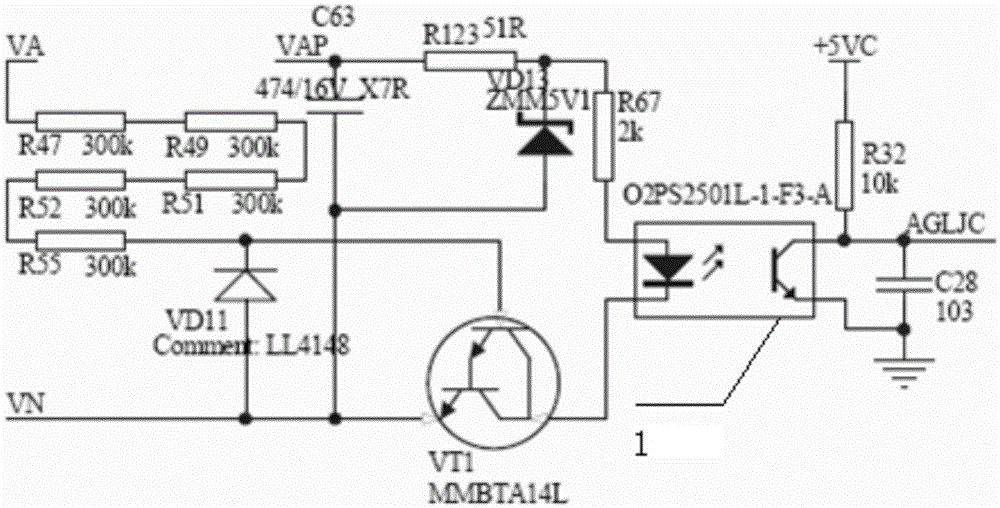Zero-crossing detection circuit
A zero-crossing detection circuit and detection unit technology, applied in the direction of measuring electrical variables, measuring current/voltage, measuring devices, etc., can solve problems such as multi-power consumption, difficulty in detection accuracy, signal attenuation, etc., and achieve strong anti-interference ability , fast convergence speed, reduce the effect of the device
- Summary
- Abstract
- Description
- Claims
- Application Information
AI Technical Summary
Problems solved by technology
Method used
Image
Examples
Embodiment 1
[0043] as attached image 3 As shown, a zero-crossing detection circuit described in this embodiment includes: a coupling unit, the coupling unit has a first input terminal 101 and a second input terminal 102, and the coupling unit is used to convert the input signal V1 of the first and second input terminals Output after coupling.
[0044] The filtering unit 103 is connected with the coupling unit to receive the input signal output by the coupling unit, and perform filtering processing on the input signal to form a filtered signal output. The first input terminal 101 is connected to one end of the primary winding of a transformer T1 through a capacitor C1, also That is, the capacitor C1 is connected between the one end of the primary winding of the transformer T1 and the first input end 101 , while the second input end 102 is connected to the opposite end of the primary winding of the transformer T1 . One end of the secondary winding of the transformer T1 is connected to the...
Embodiment 2
[0060] This embodiment is a model circuit circuit based on the circuit of Embodiment 1, as attached Figure 4 As shown, the coupling unit of the present invention has a first input terminal 101 and a second input terminal 102; the first input terminal 101 is connected to the capacitor C1, and there is a coupling between the second input terminal 102 and the output terminal of the capacitor C1. Effective inductance L1, the equivalent inductance L1 is the equivalent inductance of the transformer T1 in the first embodiment, and one end of the equivalent inductance L1 corresponding to the first input end 101 is connected to the input end of the filter unit 103, and the output end of the filter unit 103 is connected to, etc. The effective resistance R1, the equivalent resistance R1 is figure 1 The equivalent resistance of the analog-to-digital conversion unit 108 .
[0061] In a preferred embodiment of this embodiment, the opposite end of the second input end 102 and the equivalen...
Embodiment 3
[0065] This embodiment is based on the actual circuits of Embodiments 1 and 2, as attached Figure 5 As shown, the coupling unit in this embodiment has a first input terminal 101 and a second input terminal 102; the first input terminal 101 is connected to one end of the primary winding of a transformer T1 through a capacitor C1, that is, the capacitor C1 is connected to the transformer T1 Between this end of the primary winding and the first input end 101, while the second input end 102 is connected to the opposite end of the primary winding of the transformer T1; both ends of the secondary winding of the transformer T1 are connected to the LPF module 109 for enhanced detection Accuracy, discharge interference error. LPF module 109 with figure 1 and figure 2 The filter unit 103 in has the same function, where the LPF module 109 filters out the high-frequency noise of the power line.
[0066] A preferred embodiment of the present invention: For example, between the first i...
PUM
 Login to View More
Login to View More Abstract
Description
Claims
Application Information
 Login to View More
Login to View More - R&D
- Intellectual Property
- Life Sciences
- Materials
- Tech Scout
- Unparalleled Data Quality
- Higher Quality Content
- 60% Fewer Hallucinations
Browse by: Latest US Patents, China's latest patents, Technical Efficacy Thesaurus, Application Domain, Technology Topic, Popular Technical Reports.
© 2025 PatSnap. All rights reserved.Legal|Privacy policy|Modern Slavery Act Transparency Statement|Sitemap|About US| Contact US: help@patsnap.com



